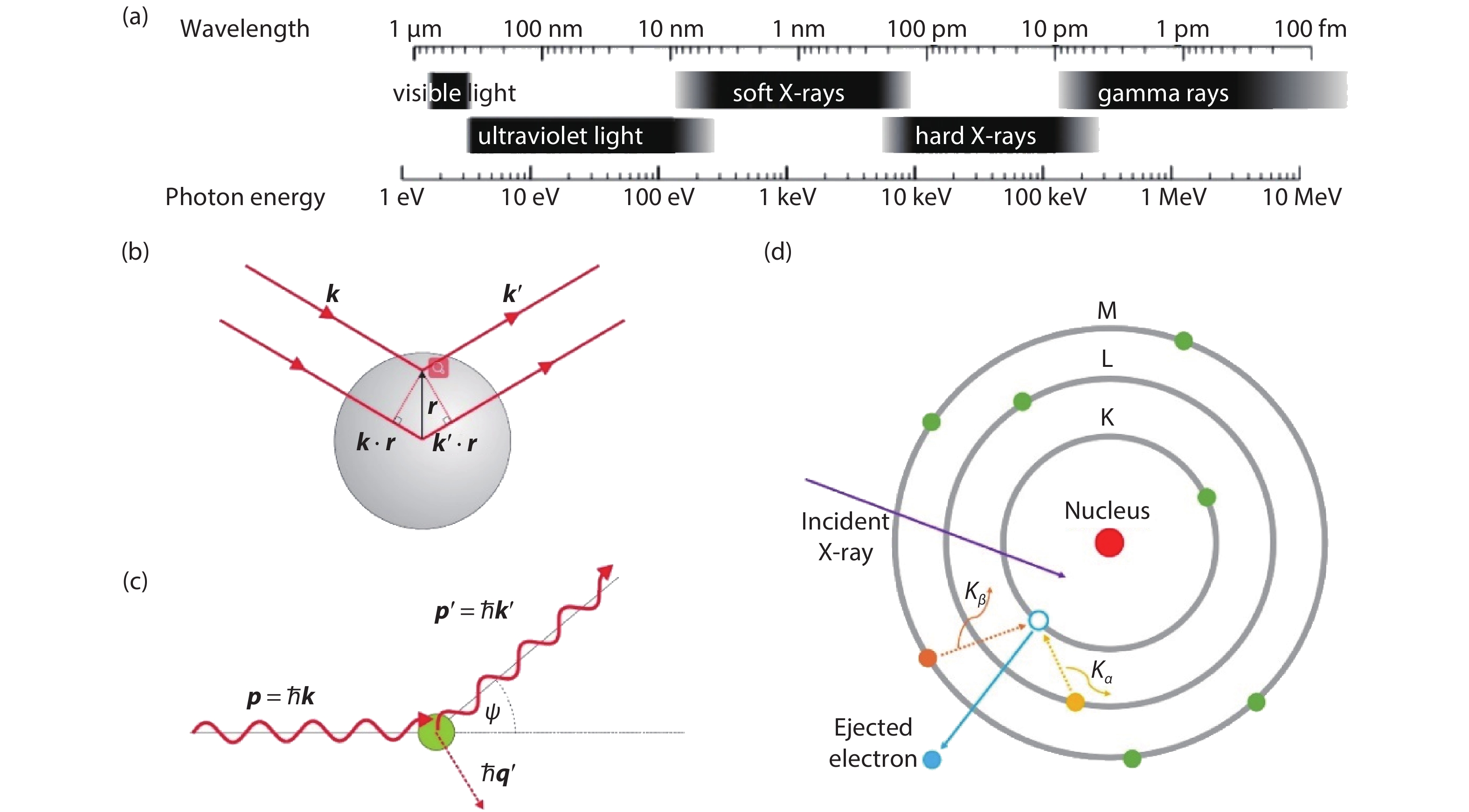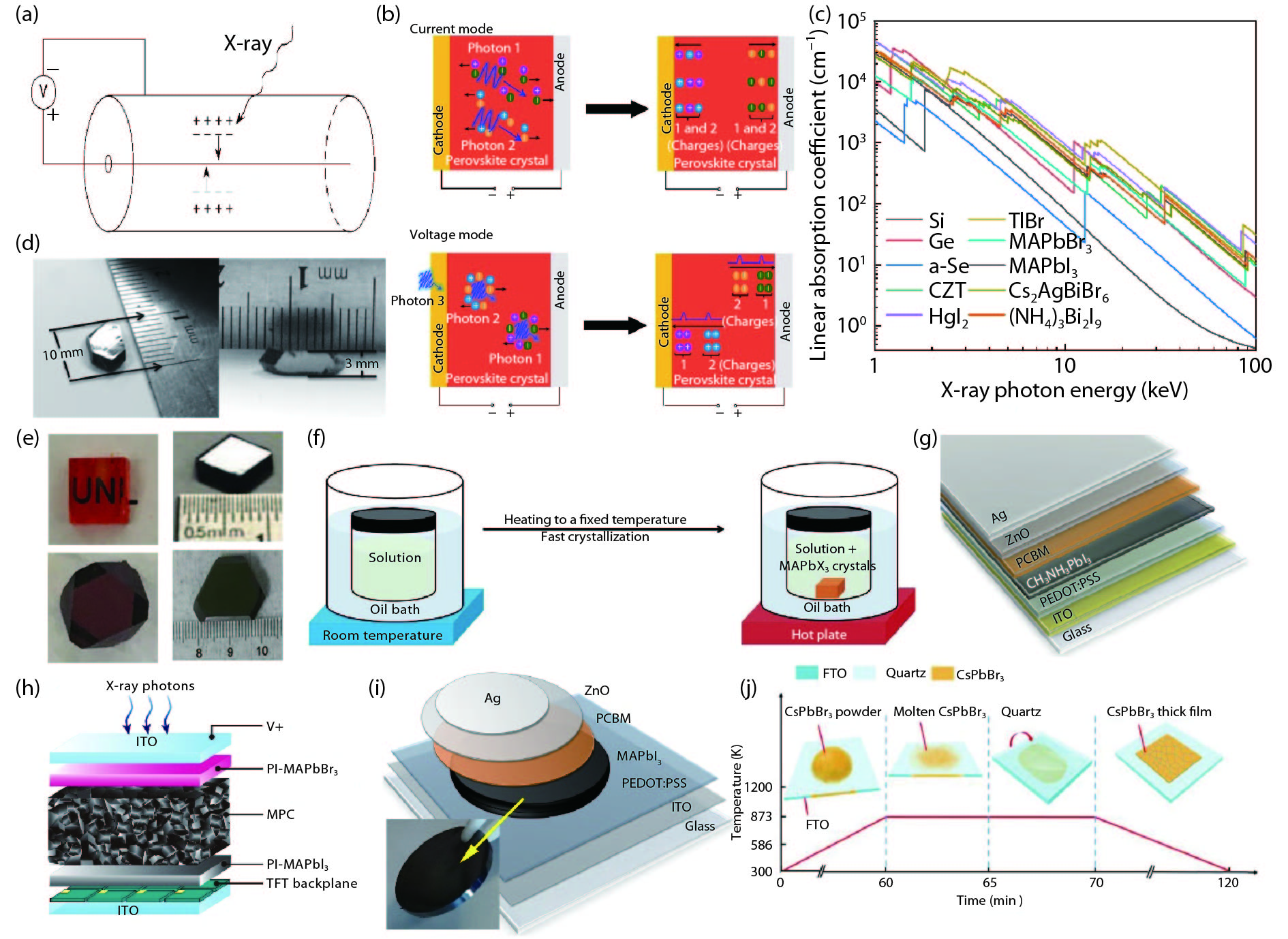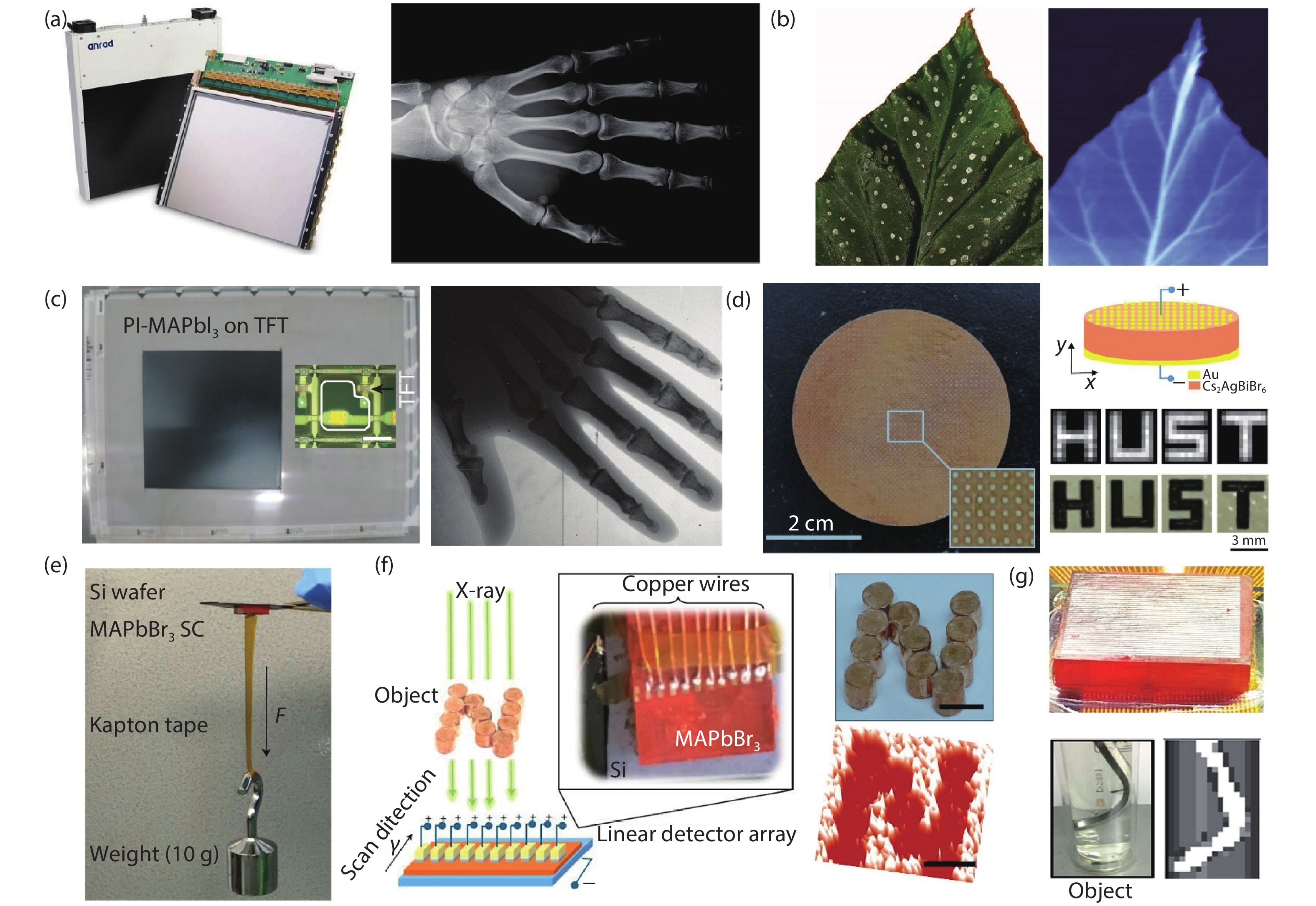| Citation: |
Yirong Su, Wenbo Ma, Yang (Michael) Yang. Perovskite semiconductors for direct X-ray detection and imaging[J]. Journal of Semiconductors, 2020, 41(5): 051204. doi: 10.1088/1674-4926/41/5/051204
****
Y R Su, W B Ma, Y Yang, Perovskite semiconductors for direct X-ray detection and imaging[J]. J. Semicond., 2020, 41(5): 051204. doi: 10.1088/1674-4926/41/5/051204.
|
Perovskite semiconductors for direct X-ray detection and imaging
DOI: 10.1088/1674-4926/41/5/051204
More Information
-
Abstract
Halide perovskites have emerged as the next generation of optoelectronic materials and their remarkable performances have been attractive in the fields of solar cells, light-emitting diodes, photodetectors, etc. In addition, halide perovskites have been reported as an attractive new class of X-ray direct detecting materials recently, owning to the strong X-ray stopping capacity, excellent carrier transport, high sensitivity, and cost-effective manufacturing. Meanwhile, perovskite based direct X-ray imagers have been successfully demonstrated as well. In this review article, we firstly introduced some fundamental principles of direct X-ray detection and imaging, and summarized the advances of perovskite materials for these purposes and finally put forward some needful and feasible directions. -
References
[1] Spahn M. X-ray detectors in medical imaging. Nucl Instrum Methods Phys Res A, 2013, 731, 57 doi: 10.1016/j.nima.2013.05.174[2] Van Eijk C W. Inorganic scintillators in medical imaging. Phys Med Biol, 2002, 47, R85 doi: 10.1088/0031-9155/47/8/201[3] Duan X, Cheng J, Zhang L, et al. X-ray cargo container inspection system with few-view projection imaging. Nucl Instrum Methods Phys Res A, 2009, 598, 439 doi: 10.1016/j.nima.2008.08.151[4] Haff R P, Toyofuku N. X-ray detection of defects and contaminants in the food industry. Sens Instrum Food Quality Safety, 2008, 2, 262 doi: 10.1007/s11694-008-9059-8[5] Chapman H N, Fromme P, Barty A, et al. Femtosecond X-ray protein nanocrystallography. Nature, 2011, 470, 73 doi: 10.1038/nature09750[6] Nielsen J A, McMorrow D. Elements of modern X-ray physics. Wiley, 2011[7] Moses W W. Scintillator requirements for medical imaging. LBNL Publications, 1999[8] Lin E C. Radiation risk from medical imaging. In: Mayo Clinic Proceedings. Elsevier, 2010, 1142[9] Knoll G F. Radiation detection and measurement. John Wiley & Sons, 2010[10] Rowlands J A. Medical imaging: Material change for X-ray detectors. Nature, 2017, 550, 47 doi: 10.1038/550047a[11] Kasap S, Frey J B, Belev G, et al. Amorphous and polycrystalline photoconductors for direct conversion flat panel X-ray image sensors. Sensors, 2011, 11, 5112 doi: 10.3390/s110505112[12] Zheng X, Chen B, Dai J, et al. Defect passivation in hybrid perovskite solar cells using quaternary ammonium halide anions and cations. Nat Energy, 2017, 2, 17102 doi: 10.1038/nenergy.2017.102[13] Xiao Z, Kerner R A, Zhao L, et al. Efficient perovskite light-emitting diodes featuring nanometre-sized crystallites. Nat Photonics, 2017, 11, 108 doi: 10.1038/nphoton.2016.269[14] Saliba M, Wood S M, Patel J B, et al. Structured organic–inorganic perovskite toward a distributed feedback laser. Adv Mater, 2016, 28, 923 doi: 10.1002/adma.201502608[15] Dou L, Yang Y M, You J, et al. Solution-processed hybrid perovskite photodetectors with high detectivity. Nat Commun, 2014, 5, 5404 doi: 10.1038/ncomms6404[16] Wei H, Fang Y, Mulligan P, et al. Sensitive X-ray detectors made of methylammonium lead tribromide perovskite single crystals. Nat Photonics, 2016, 10, 333 doi: 10.1038/nphoton.2016.41[17] Pan W, Wu H, Luo J, et al. Cs2AgBiBr6 single-crystal X-ray detectors with a low detection limit. Nat Photonics, 2017, 11, 726 doi: 10.1038/s41566-017-0012-4[18] Zhuang R, Wang X, Ma W, et al. Highly sensitive X-ray detector made of layered perovskite-like (NH4)3Bi2I9 single crystal with anisotropic response. Nat Photonics, 2019, 13, 602 doi: 10.1038/s41566-019-0466-7[19] Wei W, Zhang Y, Xu Q, et al. Monolithic integration of hybrid perovskite single crystals with heterogenous substrate for highly sensitive X-ray imaging. Nat Photonics, 2017, 11, 315 doi: 10.1038/nphoton.2017.43[20] Yakunin S, Sytnyk M, Kriegner D, et al. Detection of X-ray photons by solution-processed lead halide perovskites. Nat Photonics, 2015, 9, 444 doi: 10.1038/nphoton.2015.82[21] Kim Y C, Kim K H, Son D Y, et al. Printable organometallic perovskite enables large-area, low-dose X-ray imaging. Nature, 2017, 550, 87 doi: 10.1038/nature24032[22] Martin J E. Physics for radiation protection: a handbook. John Wiley & Sons, 2006[23] Wei H, Huang J. Halide lead perovskites for ionizing radiation detection. Nat Commun, 2019, 10, 1066 doi: 10.1038/s41467-019-08981-w[24] Devanathan R, Corrales L R, Gao F, et al. Signal variance in gamma-ray detectors—A review. Nucl Instrum Methods Phys Res A, 2006, 565, 637 doi: 10.1016/j.nima.2006.05.085[25] Kabir M. Effects of charge carrier trapping on polycrystalline PbO X-ray imaging detectors. J Appl Phys, 2008, 104, 074506 doi: 10.1063/1.2990765[26] Klein C A. Bandgap dependence and related features of radiation ionization energies in semiconductors. J Appl Phys, 1968, 39, 2029 doi: 10.1063/1.1656484[27] Alig R, Bloom S. Electron-hole-pair creation energies in semiconductors. Phys Rev Lett, 1975, 35, 1522 doi: 10.1103/PhysRevLett.35.1522[28] van Heerden P J. The crystalcounter. Noord-Holl Uitg Mij, 1945[29] McKay K G. A. germanium counter. Phys Rev, 1949, 76, 1537 doi: 10.1103/PhysRev.76.1537[30] Guerra M, Manso M, Longelin S, et al. Performance of three different Si X-ray detectors for portable XRF spectrometers in cultural heritage applications. J Instrum, 2012, 7, C10004 doi: 10.1088/1748-0221/7/10/C10004[31] Owens A, Peacock A. Compound semiconductor radiation detectors. Nucl Instrum Methods Phys Res A, 2004, 531, 18 doi: 10.1016/j.nima.2004.05.071[32] Del Sordo S, Abbene L, Caroli E, et al. Progress in the development of CdTe and CdZnTe semiconductor radiation detectors for astrophysical and medical applications. Sensors, 2009, 9, 3491 doi: 10.3390/s90503491[33] Luke P, Rossington C, Wesela M. Low energy X-ray response of Ge detectors with amorphous Ge entrance contacts. IEEE Trans Nucl Sci, 1994, 41, 1074 doi: 10.1109/23.322861[34] Szeles C. CdZnTe and CdTe materials for X-ray and gamma ray radiation detector applications. Phys Status Solidi B, 2004, 241, 783 doi: 10.1002/pssb.200304296[35] Zentai G, Schieber M, Partain L, et al. Large area mercuric iodide and lead iodide X-ray detectors for medical and non-destructive industrial imaging. J Cryst Growth, 2005, 275, e1327 doi: 10.1016/j.jcrysgro.2004.11.105[36] Schieber M M, Zuck A, Melekhov L, et al. High-flux X-ray response of composite mercuric iodide detectors. In: Hard X-Ray, Gamma-Ray, and Neutron Detector Physics. International Society for Optics and Photonics, 1999, 296[37] Street R, Ready S, Van Schuylenbergh K, et al. Comparison of PbI2 and HgI2 for direct detection active matrix X-ray image sensors. J Appl Phys, 2002, 91, 3345 doi: 10.1063/1.1436298[38] Schieber M, Hermon H, Zuck A, et al. Thick films of X-ray polycrystalline mercuric iodide detectors. J Cryst Growth, 2001, 225, 118 doi: 10.1016/S0022-0248(01)00832-6[39] Zentai G, Partain L D, Pavlyuchkova R, et al. Mercuric iodide and lead iodide X-ray detectors for radiographic and fluoroscopic medical imaging In: Medical Imaging 2003: Physics of Medical Imaging. International Society for Optics and Photonics, 2003, 77[40] Yun M S, Cho S H, Lee R, et al. Investigation of PbI2 film fabricated by a new sedimentation method as an X-ray conversion material. Jpn J Appl Phys, 2010, 49, 041801 doi: 10.1143/JJAP.49.041801[41] Shah K, Street R, Dmitriyev Y, et al. X-ray imaging with PbI2-based a-Si: H flat panel detectors. Nucl Instrum Methods Phys Res A, 2001, 458, 140 doi: 10.1016/S0168-9002(00)00857-3[42] Simon M, Ford R, Franklin A, et al. Analysis of lead oxide (PbO) layers for direct conversion X-ray detection. IEEE Symposium Conference Record Nuclear Science, 2004, 4268[43] Destefano N, Mulato M. Influence of multi-depositions on the final properties of thermally evaporated TlBr films. Nucl Instrum Methods Phys Res A, 2010, 624, 114 doi: 10.1016/j.nima.2010.09.006[44] Hitomi K, Kikuchi Y, Shoji T, et al. Improvement of energy resolutions in TlBr detectors. Nucl Instrum Methods Phys Res A, 2009, 607, 112 doi: 10.1016/j.nima.2009.03.129[45] Brenner T M, Egger D A, Kronik L, et al. Hybrid organic–inorganic perovskites: low-cost semiconductors with intriguing charge-transport properties. Nat Rev Mater, 2016, 1, 15007 doi: 10.1038/natrevmats.2015.7[46] de Arquer F P G, Armin A, Meredith P, et al. Solution-processed semiconductors for next-generation photodetectors. Nat Rev Mater, 2017, 2, 16100 doi: 10.1038/natrevmats.2016.100[47] Kasap S. Low-cost X-ray detectors. Nat Photonics, 2015, 9, 420 doi: 10.1038/nphoton.2015.108[48] Lang F, Nickel N H, Bundesmann J, et al. Radiation hardness and self-healing of perovskite solar cells. Adv Mater, 2016, 28, 8726 doi: 10.1002/adma.201603326[49] Yang S, Xu Z, Xue S, et al. Organohalide lead perovskites: more stable than glass under gamma-ray radiation. Adv Mater, 2019, 31, 1805547 doi: 10.1002/adma.201805547[50] Huang J, Yuan Y, Shao Y, et al. Understanding the physical properties of hybrid perovskites for photovoltaic applications. Nat Rev Mater, 2017, 2, 17042 doi: 10.1038/natrevmats.2017.42[51] Lang F, Shargaieva O, Brus V V, et al. Influence of radiation on the properties and the stability of hybrid perovskites. Adv Mater, 2018, 30, 1702905 doi: 10.1002/adma.201702905[52] Dong Q, Fang Y, Shao Y, et al. Electron–hole diffusion lengths > 175 μm in solution-grown CH3NH3PbI3 single crystals. Science, 2015, 347, 967 doi: 10.1126/science.aaa5760[53] Ye F, Lin H, Wu H, et al. High-quality cuboid CH3NH3PbI3 single crystals for high performance X-ray and photon detectors. Adv Funct Mater, 2019, 29, 1806984 doi: 10.1002/adfm.201806984[54] Saidaminov M I, Abdelhady A L, Murali B, et al. High-quality bulk hybrid perovskite single crystals within minutes by inverse temperature crystallization. Nat Commun, 2015, 6, 1 doi: 10.1038/ncomms8586[55] Shrestha S, Fischer R, Matt G J, et al. High-performance direct conversion X-ray detectors based on sintered hybrid lead triiodide perovskite wafers. Nat Photonics, 2017, 11, 436 doi: 10.1038/nphoton.2017.94[56] Pan W, Yang B, Niu G, et al. Hot-pressed CsPbBr3 quasi-monocrystalline film for sensitive direct X-ray detection. Adv Mater, 2019, 31, 1904405 doi: 10.1002/adma.201904405[57] Kasap S. X-ray sensitivity of photoconductors: application to stabilized a-Se. J Phys D, 2000, 33, 2853 doi: 10.1088/0022-3727/33/21/326[58] Heiss W, Brabec C. X-ray imaging: Perovskites target X-ray detection. Nat Photonics, 2016, 10, 288 doi: 10.1038/nphoton.2016.54[59] Wang X, Zhao D, Qiu Y, et al. PIN diodes array made of perovskite single crystal for X-ray imaging. Phys Status Solidi RRL, 2018, 12, 1800380 doi: 10.1002/pssr.201800380[60] Huang Y, Qiao L, Jiang Y, et al. A-site cation engineering for highly efficient MAPbI3 single-crystal X-ray detector. Angew Chem Int Ed, 2019, 58, 17834 doi: 10.1002/anie.201911281[61] Eperon G E, Paterno G M, Sutton R J, et al. Inorganic caesium lead iodide perovskite solar cells. J Mater Chem A, 2015, 3, 19688 doi: 10.1039/C5TA06398A[62] Liu J, Shabbir B, Wang C, et al. Flexible, printable soft-X-ray detectors based on all-inorganic perovskite quantum dots. Adv Mater, 2019, 31(30), 1901644 doi: 10.1002/adma.201901644[63] Yuan W, Niu G, Xian Y, et al. In situ regulating the order–disorder phase transition in Cs2AgBiBr6 single crystal toward the application in an X-ray detector. Adv Funct Mater, 2019, 29, 1900234 doi: 10.1002/adfm.201900234[64] Zhang B, Liu X, Xiao B, et al. High performance X-ray detection based on one-dimensional inorganic halide perovskite CsPbI3. J Phys Chem Lett, 2020, 11, 43 doi: 10.1021/acs.jpclett.9b03523[65] Wu C, Zhang Q, Liu G, et al. From Pb to Bi: a promising family of Pb-free optoelectronic materials and devices. Adv Energy Mater, 2019, 10, 1902496 doi: 10.1002/aenm.201902496[66] Steele J A, Pan W, Martin C, et al. Photophysical pathways in highly sensitive Cs2AgBiBr6 double-perovskite single-crystal X-ray detectors. Adv Mater, 2018, 30, 1804450 doi: 10.1002/adma.201804450[67] Xu Z, Liu X, Li Y, et al. Exploring lead-free hybrid double perovskite crystals of (BA)2CsAgBiBr7 with large mobility-lifetime product toward X-ray detection. Angew Chem Int Ed, 2019, 58, 15757 doi: 10.1002/anie.201909815[68] Yin L, Wu H, Pan W, et al. Controlled cooling for synthesis of Cs2AgBiBr6 single crystals and its application for X-ray detection. Adv Opt Mater, 2019, 7, 1900491 doi: 10.1002/adom.201900491[69] Yao L, Niu G, Yin L, et al. Bismuth halide perovskite derivatives for direct X-ray detection. J Mater Chem C, 2020, 8, 1239 doi: 10.1039/C9TC06313G[70] Tao K, Li Y, Ji C, et al. A lead-free hybrid iodide with quantitative response to X-ray radiation. Chem Mater, 2019, 31, 5927 doi: 10.1021/acs.chemmater.9b02263[71] Rikner G, Grusell E. Effects of radiation damage on p-type silicon detectors. Phys Med Biol, 1983, 28, 1261 doi: 10.1088/0031-9155/28/11/006[72] Bellazzini R, Spandre G, Brez A, et al. Chromatic X-ray imaging with a fine pitch CdTe sensor coupled to a large area photon counting pixel ASIC. J Instrum, 2013, 8, C02028 doi: 10.1088/1748-0221/8/02/C02028[73] Ivanov Y M, Kanevsky V, Dvoryankin V, et al. The possibilities of using semi-insulating CdTe crystals as detecting material for X-ray imaging radiography. Phys Status Solidi C, 2003, 0(3), 840 doi: 10.1002/pssc.200306258[74] Zheng X, Zhao W, Wang P, et al. Ultrasensitive and stable X-ray detection using zero-dimensional lead-free perovskites. J Energy Chem, 2020, 49, 299 doi: 10.1016/j.jechem.2020.02.049[75] Büchele P, Richter M, Tedde S F, et al. X-ray imaging with scintillator-sensitized hybrid organic photodetectors. Nat Photonics, 2015, 9, 843 doi: 10.1038/nphoton.2015.216[76] Samei E, Flynn M J, Reimann D A. A method for measuring the presampled MTF of digital radiographic systems using an edge test device. Med Phys, 1998, 25, 102 doi: 10.1118/1.598165[77] Hoheisel M, Batz L, Mertelmeier T, et al. Modulation transfer function of a selenium-based digital mammography system. IEEE Trans Nucl Sci, 2006, 53, 1118 doi: 10.1109/TNS.2006.874953[78] Kabir M Z, Kasap S. Modulation transfer function of photoconductive X-ray image detectors: effects of charge carrier trapping. J Phys D, 2003, 36, 2352 doi: 10.1088/0022-3727/36/19/006[79] Hunter D M, Belev G, Kasap S, et al. Measured and calculated K-fluorescence effects on the MTF of an amorphous-selenium based CCD X-ray detector. Med Phys, 2012, 39, 608 doi: 10.1118/1.3673957[80] Kozorezov A G, Wigmore J, Owens A, et al. The effect of carrier diffusion on the characteristics of semiconductor imaging arrays. Nucl Instrum Methods Phys Res A, 2004, 531, 52 doi: 10.1016/j.nima.2004.05.073 -
Proportional views






 DownLoad:
DownLoad:

















